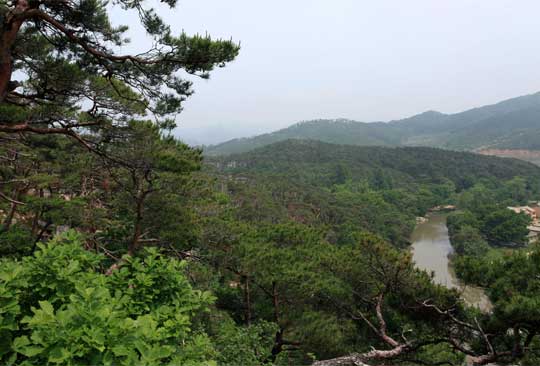Soktam Kugok
Soktam Kugok is a scenic spot in the middle course of Soktam stream, Pyoksong County, South Hwanghae Province, which rises on Kon Peak of the Suyang range and runs into Hwangpho at Haeju Bay.
From olden times, Soktam Kugok was named after a stone pond and nine meanders, which runs 8 kilometers long. It was highly appreciated by our people for its valley beauty with crystal-clear water, evergreen pine wood and seasonal landscape such as flowers in spring, green foliage in summer, maples in autumn and snowscapes in winter. Its landscape got to be widely known through Song of Kosankugok (1579) written by Ri I (1536-1584), which sang the natural scenery of Soktam.
Soktam Kugok characterized by distinctive landscape at every meander presents scenic beauties peculiar to a valley.
First meander beginning from the south is called Kwanam, which was named after the shape of a big rock on top of the mountain which looked like a kat (a traditional Korean hat). The sunrise glow in the sky at Kwanam is spectacular.
Second meander is called Hwaam. There are many rocks of various shapes, which are covered with fragrant light pink azaleas in spring, and hence its name.
Third meander is Chwibyong, about 1 km up from the second meander. It is screened by moss-covered mysterious rocks and cliffs, on which trees grow thickly to give more refreshment.
Fourth meander, about one kilometer away from the third, is Songae, that was called after the pine trees overgrown on a high cliff. The sheer cliff, old pine trees on it and the mirror-like clear and blue ponds below it make up a beautiful scene.
Another bend leads to the fifth meander called Unbyong, which is the most beautiful one among the nine meanders. A shadow of a mountain falls on the clear and blue Soktam stream while the old trees such as armful-thick pine and zelkova trees at the bank of it cover the sky. In the woods, there are ancient buildings such as Yogum Pavilion and Sohyon Confucian School which show the outstanding architecture of our people highlighting the ancient scenery. On a hill nearby stands Chonggye Hall among the old zelkova and ginkgo trees, where Ri Ryul Gok taught his students.
About one kilometer further up from there is sixth meander called Johyop. It forms a natural fishing place that a pool and bedrock seem to have intentionally created.
About 500 meters further leads to seventh meander called Phungam, which is named after the maples covering the valley including the curious rocks in autumn.
Eighth meander, Kumthan, is a clear ford not far from the seventh. It is said that on a quiet moonlit night the waterflow rolling down the ford below the cliff sounds like playing a Komungo (a Korean lute), hence its name.
Ninth meander is a little upward from the eighth along the waters. It was called Munsan, for it was good and quiet for reading books. Its winter scenery is much more beautiful, surrounded by trees and towering rocks.
Like this, Soktam Kugok is a scenic spot with distinctive beautiful landscape according to the seasons from the spring scenery of Kwanam to the winter scenery of Munsan.
